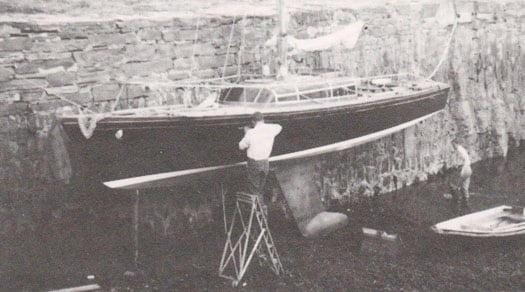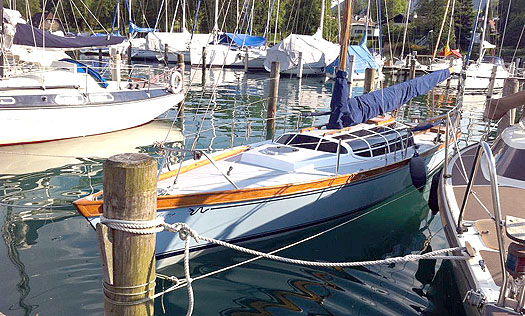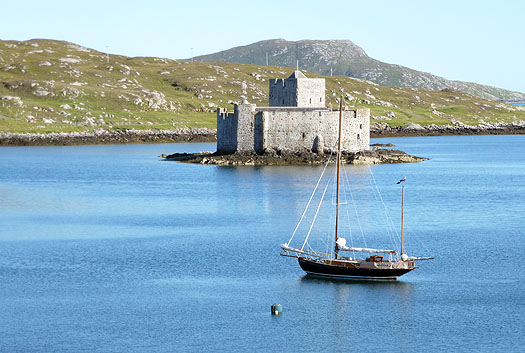#D2D – The 78ft Reichel Pugh-designed Whisper, course record holder for the Dun Laoghaire to Dingle Race, is leading the charge for Ireland under the command of Mark Dicker in the RORC Caribbean 600 in a fortnight's time. In all, there's direct Irish input into four of the fifty entries. And as the inaugural staging of this annual "instant classic" back in 2008 saw the overall win going to Adrian Lee's Cookson 50 Lee Overlay Partners, Ireland has an almost proprietorial interest in racing out of Antigua on Monday February 18th around various choice Caribbean islands, and back to Antigua again in the midst of its warm blue sea.
Or more accurately, it's Dublin Bay which seems to be claiming ownership. Michael Boyd of Dun Laoghaire, who was overall winner of the Round Ireland in 1996 with the J/35 Big Ears when there was a record fleet of 55 boats, has teamed up with clubmate Niall Dowling and American-based John Cunningham to charter the First 40 Lancelot II in Antigua. Although the First 40s may have not yet acquired the legendary status of their predecessors, the First 40.7, their debut in 2010 was quite something – they took first and second in the Sydney-Hobart Race that year, and there's half a dozen of them cutting the mustard in RORC races in Europe.
As for Whisper, she's supposedly a cruiser-racer. But she's a wolf in sheep's clothing – her fifth overall in the 2009 Fastnet Race was a matter for very favourable comment from the pundits, and her speedy scamper to Dingle that same year came within an ace of sailing the 260-mile course within 24 hours. She did the Caribbean 600 last year and notched a respectable 6th in Class and 12th overall, but at one stage was much better placed.

Wolf in sheep's clothing – Whisper pretending to be a cruising boat in Castletownbere as she makes her way home in easy stages after establishing the course record in the Dingle Race. Photo: W M Nixon
Another cruiser-racer with winning potential is Alan McGettigan's recently-acquired Swan 48 Wolfhound, which will eventually call Dun Laoghaire home. But at the moment she's trying to make the best of winter weather windows to make her way from east coast USA to Bermuda, thence to Tortola, and on to Antigua for the start in the nick of time.
Up among the biggest boats in the fleet is professional skipper Peter Metcalfe from Northern Ireland, who started his offshore racing on his father's Ruffian 23. You could fit a Ruffian 23 into the saloon of his current command, the 100ft Liara, built in 2009 by Performance Yachts of New Zealand. But with Mike Slade's Leopard – holder of the Round Ireland Course record since 2008 – also in the Caribbean 600 this time round, Liara has a race on her hands, as the fleet includes several much larger Superyachts.
And there are some potent smaller craft too, though "smaller" in Caribbean 600 terms is very relative. American Ron O'Hanley with his Cookson 50 Privateer only lost out on the overall win last year because he was carrying a penalty for a rule infringement, so he's back to sort out unfinished business, and if he does the business, we'll claim him as Irish.
Another "almost made it" is the Oyster Lightwave 48 Scarlet Oyster campaigned by the Applebey family. The two Schumacher-designed Lightwaves – the 395 and the 48 briefly produced by Oyster Marine - had been almost forgotten, even though there were three of them in Cork. But the Appleby family saw potential in one of them, gave her an upgrade and a new keel and rudder, and hey presto, they've a handy-sized contender at a fraction of the price of a new boat, a tale for our times in the midst of all these extraordinary superyachts.
THE GHOST OF BLACK SOO SAILS ON
The story here a fortnight ago about the boats which had raced 1750 miles downwind from Cape Town to St Helena over Christmas and the New Year for the Governor's Cup, and then availed of a "sailing ski lift" to be shipped back to the Cape on Royal Mail vessel serving the remote island, has rung a bell or two.

Martinus Groenewald's RCOD Reaction off Cape Town. The winner of the recent Governor's Cup race to St Helena, she is a hull sister of the van de Stadt-designed Black Soo, but her larger coachroof provides more space in the 6.9ft beam.
It was commented that the winner, Martinhus Groenewald's Reaction, appeared to be related to the famous van de Stadt designed hyper-narrow and hyper-light Black Soo, which always looked modern despite being built as long ago as 1957. Turns out that they're pretty much hull sisters. The Royal Cape One Designs from 1961 were evolved from Black Soo's sister Zeeslang, which was the first to the hull design, and was built for Kees Bruynzeel, the Dutch plywood potentate.

Black Soo at Portaferry in 1963, showing the stark hull profile which always seemed ahead of its time Photo: W M Nixon
But although Zeeslang was subsequently restored in South Africa, and then sold to Switzerland where she is now a treasured classic, poor old Black Soo, which first came to Ireland in 1962 with Dick and Billy Brown of Portaferry, eventually succumbed to the Irish weather which is murder for even the finest plywood, and was broken up at Poolbeg in Dublin three or four years ago.
One of the problems with marine ply construction is that it provides nooks and crannies where rainwater can lie, and as the original plywood-built Royal Cape ODs were very hard raced, they soon showed their age. Johnny Wolfe of Baltimore was telling me that he raced on them in South Africa in 1972, and some of them seemed old even then.

Black Soo's sister-ship Zeeslang is now a treasured classic in Switzerland
But in 1981, a local firm in Cape Town started building a fibreglass version, and as they were able to cleverly shape the interior mouldings to be useful for the accommodation while also providing strength for the hull, it made them much roomier below. Nevertheless, with a beam of only 6.9ft it was still distinctly cosy, but with the RCOD's larger coachroof it was infinitely more commodious than either Zeeslang or Black Soo, which were noted as having "full crawling headroom".
However, when you go to all the trouble of tooling up for glassfibre series production, people wonder why you don't break away from the restrictions of the hard chine shape as dictated by plywood construction in the first place. There were those who wondered if the Royal Cape OD's renowned ability to plane offwind in big breezes at better than 20 knots without burying the nose could not be achieved with something which looked a little more elegant, and was maybe just ever so slightly roomier.
So in all, only four glassfibre Royal Cape ODs (including Reaction) were built, and the boats are no longer racing as a class. But Reaction is cherished by her owner and crew, she still can do her thing in the big breezes downwind, and the ghost of Black Soo was a happy spirit when Reaction won the Governor's Cup three weeks ago.
BOOM AND BUST
Last weekend we enthused about Turas Huiceara, the six part series on TG4 at 9.30pm on Thursdays about taking the mighty 47ft Galway hooker Naomh Bairbre southabout around Ireland to the Isle of Man, and then north to the Hebrides in pursuit of stories about the Gaelic links along the Celtic seaways.
Our apologies to those who followed our advice and don't have the cupla focal, as this week on Thursday night they forgot to switch on the sub-title button across in TG4 HQ in Connemara or Harcourt Street or wherever it is, and the Naomh Bairbre trundled along in wall-to-wall undiluted Irish.
So far, no answer has come from there in response to our email to TG4 wondering is this the way it's going to be from now on. They can hardly claim it's to preserve the atmosphere, as it's set in the midst of commercials – horrible ones at that - which are almost entirely in English, featuring English actors.
But as for St Barbara being the patron saint of sudden surprises and explosions, we certainly continued to get a bang for our buck. A week ago, it was a right old wallop for the entrance to the sea lock at Ardrishaig. This Thursday past, it was the mainboom breaking while on passage from Staffa towards Castlebay on Barra.
The mainboom on Naomh Bairbre is huge, so this softened the lads' cough more than somewhat. But they seemed resigned to doing without it, even if its sudden exit from the dramatis personae led to a somewhat unbalanced view of Castlebay, with precious little attention for the sensitively-restored Kisimul Castle. It's the ancestral stronghold of the MacNeils, who are a branch of the O'Neills.
Castlebay in Barra in the Outer Hebrides. Kisimul Castle is a stronghold of the MacNeils, an offshoot of the O'Neills. As a former outpost of Irish sea power, it deserved more detailed attention from TG4. Photo W M Nixon
Barra was and arguably still is an outpost of Irish sea power, but they didn't seem to bother with visiting the cocky little castle on its rock in the harbour. But then neither do they appear to have done anything about replacing the mainboom, which would be Number One priority for any thoroughgoing cruising man, who would approach the problem in a scavenging frame of mind.
After all, it's about the size of a telegraph pole, and there are telegraph poles in abundance in the Western Isles. But then, as this endearing programme signed off with clips of some stuff still to come, here we were, glimpsing the Highland Games in Stornoway or some such place. A giant Scotsman was making a fine job of tossing the caber. I have to admit I didn't see a caber at all. I saw a new mainboom for the Naomh Bairbre.

Would a caber do the job? The mighty mainboom on the Naomh Bairbre currently needs replacing on Turas Huiceara, TG4 Thursdays, 9.30pm.
































































